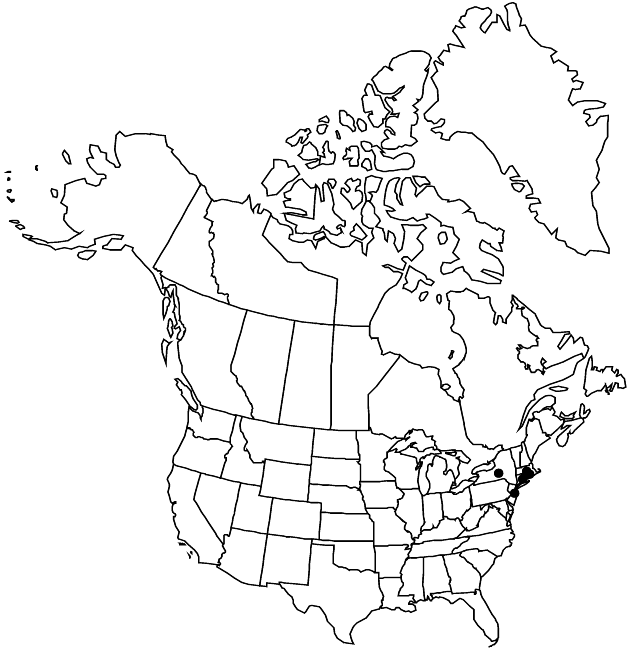Eurybia ×herveyi
Phytologia 77: 262. 1995.
Plants 25–70+ cm; in clones and clumps (with sterile rosettes), stipitate-glandular distally; rhizomes branched, herbaceous becoming woody. Stems 1–3+, erect, straight, proximally glabrous, distally sometimes sparsely strigose, stipitate-glandular. Leaves basal and cauline, firm, margins slightly revolute, crenate-serrate, scabrous, apices acuminate and mucronate, abaxial faces usually glabrescent to ± scabrous, sometimes ± sparsely strigose, gland-dotted or stipitate-glandular, adaxial sparsely puberulent, stipitate-glandular (increasingly so distally); basal withering by flowering, long-petiolate, petioles slightly winged, bases dilated and sheathing, sparsely ciliate, ± glandular, blades ovate to elliptic-ovate, 70–120 × 40–65 mm, bases rounded to sometimes slightly oblique; proximal cauline long-petiolate, petioles shorter and gradually more broadly winged distally, blades ovate to elliptic-ovate, 55–100 × 24–65 mm, gradually reduced distally; distal winged-petiolate to subpetiolate or sessile, blades ovate or elliptic to lanceolate or oblanceolate, 10–64 × 3–18 mm, gradually reduced distally, bases ± clasping, margins becoming entire (arrays). Heads (3–) 8–19+ in open, corymbiform arrays. Peduncles firm, straight, 0.4–3.5 cm, sparsely strigose, densely stipitate-glandular; bracts 0–3, oblong-lanceolate, 3–5 mm, acute, densely stipitate-glandular. Involucres campanulate, (6–) 7–11 mm, shorter than pappi. Phyllaries (18–) 25–40 in (4–) 5–6 series, appressed, lanceolate (outer) or lanceovate to oblong or linear-oblong (inner; innermost longer than 7 mm), strongly unequal, bases indurate, rounded adaxially, dark-green zones obovate to lanceolate (inner), ca. 1/3 distal portion, margins hyaline or often purplish (inner), scarious, erose, ± ciliate, apices (at least some) reflexed, ± squarrose, or twisted, rounded to obtuse (outer) or acute (inner), abaxial faces stipitate-glandular. Ray-florets 10–11; corollas ± purple, 13.1–13.5 × 1.6–2 mm. Disc-florets 25–40; corollas cream or light yellow, becoming pinkish, 7.6–8.5 mm, slightly ampliate, tubes longer than narrowly funnelform-campanulate throats, lobes erect, lanceolate-acuminate, 0.9–1.4 mm. Cypselae dark reddish-brown, cylindro-fusiform, compressed, ca. 3 mm (sterile or undeveloped), ribs [not seen], faces strigillose; pappi of tawny, (sometimes apically ± clavate) bristles 7.6–8+ mm, equaling disc corollas. 2n = 72.
Phenology: Flowering fall.
Habitat: Open woods, clearings, often sandy or acidic substrates
Elevation: 0–100 m
Distribution

Conn., Mass., N.J., N.Y., R.I.
Discussion
Eurybia ×herveyi is the F1 hybrid between E. macrophylla and E. spectabilis. L. J. Uttal (1962) proved its origin with artificial crosses, and pointed out that the two parents co-occur in some populations where their ranges overlap.
Selected References
None.
Lower Taxa
"[" is not declared as a valid unit of measurement for this property."]" is not declared as a valid unit of measurement for this property.